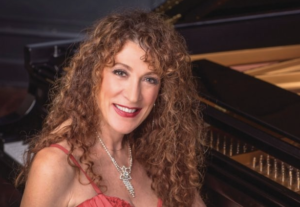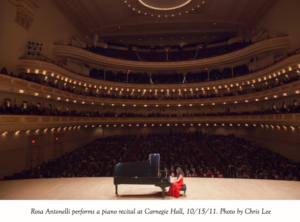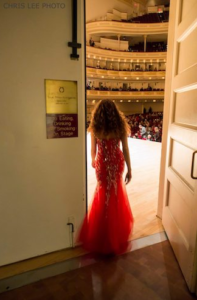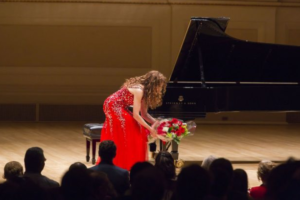Sounds of Migration and Liberty: Rosa Antonelli, the Italian-Argentinean Musician
Interview with the talented pianist, whose family is from Molise, based in NYC, that will celebrate April 25th with us performing “Libertango” by Piazzolla
Round Tripby Liliana Rosano

Apr 24 2019
Leggi in italiano
“The Italian blood still flows through my veins, even though I grew up in Argentina. My family was among the many immigrants who flocked to Argentina to try and escape the devastation of the Second World War and from fear of a possible World War Three. They had the dream of starting a new life in a new country. My mother was pregnant with me when she left Italy; I usually say that I was practically born on the ship itself”, she tells us…
Grown-up listening to classical music and Italian opera, Rosa Antonelli feels the Italian blood flowing in her veins. From her origins in Molise, from where her family moved to Argentina, to the Italian musical tradition that has accompanied her since she started playing the piano at the age of four. The Italian-Argentinean musician, born and raised in Buenos Aires, and living in New York since 1998, has been keeping the relationship with the Italian culture alive that she promotes in her concerts along with the repertoire of Argentinean and South American musicians, who nourished themselves on that Italian and European culture.
On April 25th, she will celebrate this important anniversary with La Voce di New York’s readers and friends–thanks to our partnership with United Voices 4 Peace–playing the well-known piece Libertango by Astor Piazzolla.
This piece represents for me the feeling of freedom I perceived when I was a child and heard from my family about their life in Italy before moving to Argentina. The freedom of expression, freedom of happiness and encouragement and new beginnings.

Your roots are Italian but you grew up in Argentina in an Italian family. Tell us more about your Italian roots and your relation with Italy and Italian culture.
“The Italian blood still flows through my veins, even though I grew up in Argentina. My family was among the many immigrants who flocked to Argentina to try and escape the devastation of the Second World War and from fear of a possible World War Three. They had the dream of starting a new life in a new country. My mother was pregnant with me when she left Italy; I usually say that I was practically born on the ship itself. I was given Argentinian nationality when we arrived in Buenos Aires, which gave me the status of being the only one in my family to be born outside Italy.
My mother and my mother’s parents, as well as my father’s, were originally from Molise, in the mountains. The town is Sant’Agapito, with almost all the houses on a mountain. My grandfather from my mom’s side was a famous Italian architect. Unfortunately, practically all of my family’s properties were destroyed in the war. I have a house there–my mom’s house on the side of a large hill– which overlooks the valley and river. It was rebuilt by the government many years after war. I still have relatives there from both sides and I am permanently in contact with them.
My mother was a famous opera singer and actress; that’s why at home I was raised listening to Italian operas and classical music. The language we spoke at home was Italian, so at the beginning it was hard for me to learn the new Spanish language. Our everyday life in Buenos Aires was that of a typical Italian family: the food, the customs and the growing of our own produce in the backyard made me so connected and identified with the Italian culture.
Later on in my professional career, when I started touring all over the word performing as a pianist, I immersed myself in my Italian heritage by giving concerts and performing more than 50 times in Italy in different cities, including honoring my mom after she died, with a concert at the Municipal Theater in her native province of Campobasso. I was also lecturing at different conservatories and Universities in Italy and some had incorporated the music of several composers from Argentina who had Italian roots.
Here in New York, I continued this relationship with the Italian culture. On many occasions I performed at Italian events and galas and atvarious times I was interviewed by Italian newspapers and magazines. I also received several outstanding Reviews by them after they attended my concerts at different times and places in New York City”.

Why did you decide to celebrate this important anniversary, which also marks the liberation of Italy, with La Voce di New York?
“I was introduced to La Voce di New York newspaper by the president and founder of United Voices 4 Piece, Veronica Sabbag. I admired the newspaper, La Voce di New York and its founder and director Stefano Vaccara, who is promoting Italian culture and informing the world not only about the culture, but the news related to it.
I feel honored to participate in this particular occasion because of the importance of the newspaper in New York. Personally, the liberation of Italy is very moving to me because, as I mentioned before, of how much my whole family suffered in different ways for the oppression in Italy”.
You will play “Libertango” on April 25th. How important is this piece to you and what does it represent for you?
“This piece is very important in many ways, and I will explain it to you. I believe that the Italian heritage shared by this composer permeates his music in an instinctive, even spiritual fashion. Piazzolla was a classical music composer who incorporated these harmonies in what he called the Nuevo Tango. He was encouraged to pursue his inspiration by his teachers, Nadia Boulanger in Paris and Alberto Ginastera in Argentina. He had more than a hint of Italian in him. He was the only child of Italian immigrant parents. His grandfather was a sailor from Trani, in Apulia, in Italy. In the 1930’s the family lived in Little Italy in lower Manhattan. When he formed a chamber music octet, almost all of the musicians were of Italian descent.
His teacher, Alberto Ginastera, was also of Italian heritage. Piazzolla had strong Italian roots that valued his whole life, as demonstrated in 1959 when his father died. The Tango that he wrote dedicated to his father, was called “Adios Nonino”. There is a presence beyond analysis, more suggested than explicit. And all of these composers didn’t only have to rely on their ancestral memories: each of them benefited from scholarships to study in Europe, so that the influence was not merely anecdotal or “mystical.” He had a very difficult life in many ways, because in the beginning people resisted his idea of the new classical tango. He didn’t have enough money, since many times he had to give up his rights to his music, and he had to support his family, wife and children.
After many struggles, including a heart attack, he was living in Milan, Italy when he met the famous publisher and music director, Aldo Pagani, who became a devoted follower of Piazzolla’s work; and he wanted to help him and promote his music all over the world. Right after that, in 1972, he offered him an apartment, a salary and all the rights to his music.
Piazzolla finally felt for the first time in his life, the freedom to continue his mission of composing and introducing this new Tango to the world. The first tango he composed after this new life was LIBERTANGO (published and recorded in Rome 1972, signed by A. Pagani Edizioni Musicali) which means freedom and liberty, and I found this composer and his music to be the perfect combination to perform in this particular special celebration. For me it represents the feeling of freedom I perceived when I was a child and heard from my family about their life in Italy before moving to Argentina. The freedom of expression, freedom of happiness and encouragement and new beginnings. When Piazzolla passed away in 2014, he was honored jointly by the Italian government and the Argentinian Embassy in Italy, with a monument erected in the city of Lucca, his mother’s city of origin. This was a representation of the strong connections between Argentina and Italy”.
As a world-renowned pianist, performer and professor, you promote the Latin-American as well as your Argentinian heritage. What is the message that you want to share with your audience?
“My message is that the music of the classical composers from Latin America is younger compared with the traditional classical music from Europe. But most of these composers got scholarships from their countries, to study in Europe and then when they came back, they had a mix of influences– European as well as the folklore of their countries—producing as a result, a very special classical message. I’d like to suggest to all the people to open their hearts to this particular music. When I performed at Carnegie Hall, a complete concert with all Spanish and classical Latin American composers, to my great surprise, there were almost 3,000 people in the audience and the concert was sold out. After I performed, I received notes from people asking me to inform them about my upcoming concerts with this particular music.
Starting in 2009 I decided to perform and promote classical Latin-American composers exclusively, even though prior to that year I had performed more than 1,500 concerts with a traditional repertoire. I recorded my first CD, “Esperanza Sounds of Hope”, for Albany Records, celebrating the success and special meaning of this music. All the composers were immigrants who had moved to Argentina with the hope of a new life and new beginnings.”

Which are your favorite Italian artists, musicians, performers and what kind of music did you grow up with?
“My favorite Italian artists that I grew up with, were Michelangelo, Donatello and Da Vinci. At my home we frequently talked about them with my family, especially with my mother and grandfather on my father’s side. I used to listen to singers from Italy and more than anything, when most of my uncles were able to come to Argentina, we would have a musical gathering together on Sundays, since all of them played an instrument or sang. In their native town of Sant’Agapito, it was a tradition that all the residents had to learn and pursue a musical instrument. During the Sunday gatherings they played Italian traditional songs and many times I played the piano and they sang, “Torn’ a Surrient’” or O’ Sol’ mio”. And also, arias from the Italian Operas. Since my mom had been an opera singer in Italy, I listened to classical music all the time, especially since I had started learning the piano at the age of four”.
Would you choose songs/pieces which represent the best of the classical Italian tradition, the Argentinian culture, and the NY music scene?
“Yes, of course! This has been my mission and passion since 2009, through recordings, performances, interviews in magazines and newspapers, and television presentations. Almost 86 percent of the composers in Argentina have Italian ancestors!”
How has the music scene in New York city, where you live, been changing? What’s the difference with Argentina?
“Since I moved to New York in 1998, my impression has been that people are eager to hear new musical languages. After hundreds of performances in the United States–including several with big audiences at Carnegie Hall–this has been confirmed. The difference is that in Argentina they continue more with the traditional musical expressions”.
You moved to US like your parents moved to Italy. What brought you to the USA? The same desire and hope that brought your parents to Argentina?
“I was very tired in Buenos Aires of all the problems with the government, all the restrictions that affected the culture in Argentina, And financially the country was terrible. Musicians and artists were not able to continue growing in their careers. All was extremely limited and a lot of Violence. Also, the fact, that at the same time when I came back from a long tour in Europe, Asia, and Africa, by destiny, I lost most of the member of my family in 8 months, my mom, my grandfather. I was devastated. When after a performance in Europe, I was asked to become a STEINWAY artist and come to New York, that was the opening to my new life. It is similar to my family history MY hope I think was the same and I am very happy I followed my heart and dreams”.
